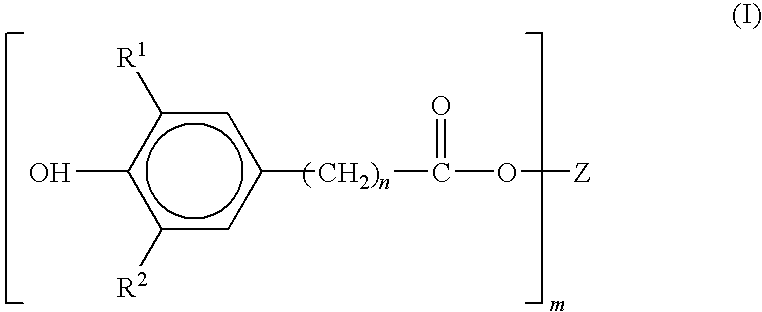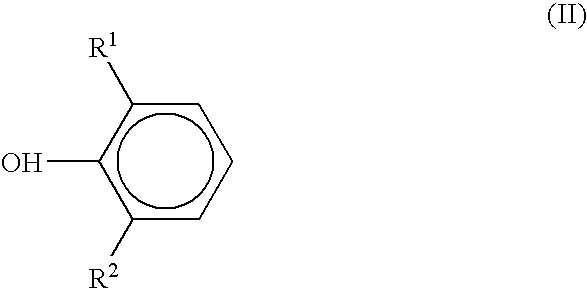Preparation of sterically hindered hydroxyphenylcarboxylic acid esters
a technology of hydroxyphenylcarboxylic acid and esters, which is applied in the field of chemical composition preparation, can solve the problems of increasing the total acidity of organic materials, increasing and increasing the risk of oxidative and thermal deterioration, so as to improve the efficiency of catalyst removal and reduce the cost of water wash steps. , the effect of reducing the cost of water wash steps
- Summary
- Abstract
- Description
- Claims
- Application Information
AI Technical Summary
Benefits of technology
Problems solved by technology
Method used
Image
Examples
example 1
[0159]This example demonstrates a two-step method for the production of 3,5-di-tert-butyl-4-hydroxyhydrocinnamic acid, isooctyl ester, which is suitable for use as an antioxidant.
[0160]Step 1: Michael Reaction.
[0161]A 1-liter round bottom Pyrex flask equipped with a magnetic stir bar, temperature probe, heating mantle, and total condenser for distillate removal was used. The flask was initially charged with 350.7 g of molten 2,6-di-tert-butylphenol (“2,6-DTBP”, 1.70 mol) at 40 to 50° C., 2.42 g of potassium hydroxide (KOH) pellet, and 14.7 g of DMSO. The pressure was then reduced to 15 mm Hg and the temperature was increased from 40° C. to 115° C. over 70 minutes to remove the water by-product. The resulting white slurry was then cooled to 110° C.
[0162]A water-cooled total reflux condenser and a 250-ml addition funnel containing 155.6 g of methyl acrylate were installed to the reactor. The methyl acrylate (“MA”) was added dropwise over 30 minutes, during which the temperature of the...
example 2
[0168]This example demonstrates another two-step method for the production of 3,5-di-tert-butyl-4-hydroxyhydrocinnamic acid, isooctyl ester, which is suitable for use as an antioxidant.
[0169]Step 1: Michael Reaction.
[0170]A 12-liter round bottom Pyrex flask equipped with an overhead agitator, temperature probe, heating mantle, and a reflux condenser in series of a total condenser for distillate removal were used. The flask was initially charged with 4126.4 g of molten 2,6-DTBP (20.0 mol) at 40 to 50° C., 28.1 g of KOH pellet (0.50 mol), and 85.9 g of DMSO (1.1 mol). The pressure was then reduced to 20 mm Hg and the temperature was increased from 40° C. to 126° C. over 76 minutes to remove the water by-product. The resulting white slurry was then cooled to 110° C.
[0171]Cooling water was then put to the jacket of the reflux condenser and 995.2 g of methyl acrylate (11.56 mol) was then added dropwise from a 1000-ml funnel to the reactor over 37 minutes, during which time the reactor te...
example 3
[0177]This example illustrates how an aqueous acid such as phosphoric acid can be used, in a process without the need to employ water washings, to produce a hindered phenolic ester product (2,6-di-tert-butyl-4-hydroxyhydrocinnamic acid, butyl ester) that contains very low levels of potassium catalyst residues.
[0178]For this example, 206.4 g of 2,6-DTBP (1.00 mol), 50.8 g toluene, and 1.17 g KOH pellets (0.020 mol, 2.0 mol %) are charged into a 1 liter flask equipped with mechanical stirrer, connected to a Dean-Stark trap and under N2 atmosphere. The mixture is heated to 140° C. to remove water as a toluene azeotrope. A white slurry was obtained and 14.1 g of toluene was collected. Butyl acrylate (130.2 g, 1.015 mol) was then added in one portion over two minutes to the white slurry. The Dean-Stark trap was removed and replaced by a cooling condenser. The resulting mixture was heated for 5 hours at 140° C., during which time 14 g toluene was collected and the resulting orange reactio...
PUM
| Property | Measurement | Unit |
|---|---|---|
| temperature | aaaaa | aaaaa |
| temperature | aaaaa | aaaaa |
| temperature | aaaaa | aaaaa |
Abstract
Description
Claims
Application Information
 Login to View More
Login to View More - R&D
- Intellectual Property
- Life Sciences
- Materials
- Tech Scout
- Unparalleled Data Quality
- Higher Quality Content
- 60% Fewer Hallucinations
Browse by: Latest US Patents, China's latest patents, Technical Efficacy Thesaurus, Application Domain, Technology Topic, Popular Technical Reports.
© 2025 PatSnap. All rights reserved.Legal|Privacy policy|Modern Slavery Act Transparency Statement|Sitemap|About US| Contact US: help@patsnap.com



